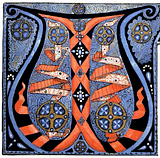Cosmic Egg
This article is part of a series exploring cross-cultural motifs in world spirituality.
 Which came first, the chicken or the egg? Since time immemorial children have racked their brains over this conundrum, furrowing their brows in consternation as they wrestle to unpack the layers of paradox. In philosophy, the question is referred to as a causality dilemma. It deals with much more than causality, however. It touches upon the question of origins, the possibility of creation, the essential nature of biological life, and much more. Aristotle sidestepped the question by claiming that both chickens and eggs recede back infinitely in time — a philosopher’s answer if there ever was one. But the egg discussed in this article was not laid by any chicken. It is the cosmic egg.
Which came first, the chicken or the egg? Since time immemorial children have racked their brains over this conundrum, furrowing their brows in consternation as they wrestle to unpack the layers of paradox. In philosophy, the question is referred to as a causality dilemma. It deals with much more than causality, however. It touches upon the question of origins, the possibility of creation, the essential nature of biological life, and much more. Aristotle sidestepped the question by claiming that both chickens and eggs recede back infinitely in time — a philosopher’s answer if there ever was one. But the egg discussed in this article was not laid by any chicken. It is the cosmic egg.
The concept of the cosmic or world egg spans across human culture and forms the basis of many creation stories. Sometimes it is laid by a primordial deity or ur-god. Sometimes it preexists the gods and even the universe itself, a mysterious object containing all reality in its potential form. Whatever the case, the hatching of the egg is the fundamental event spawning the perceptible universe around us.
Take, for instance, the Rg Veda, a collection of sanskrit hymns which together comprise the oldest known religious text in an Indo-European language. In the Rg Veda the cosmic egg is called Brahmāṇḍa, a conjunction of the words Brahmā (the name of the Vedic creator god and a term for the transcendent principle of reality itself) and aṇḍa (egg). The word Brahmā is in turn derived from a root meaning to “to swell, expand, grow, enlarge.” Thus the Brahmāṇḍa is the expanding egg which contains the cosmos. A closely related concept is the Hiraṇyagarbha, the golden womb or golden egg, which is also mentioned in the Rg Veda as the ultimate source of the perceptible universe.
“On mighty waters floated the universal egg of the Golden Womb, Hiranyagarbha, which gave birth to the flame of life, the One Spirit of all the Gods.” — Rg Veda (X.121)
The cosmic egg is conceptually linked to holy diagrams known in Hinduism as yantra. The Sri Yantra, for example, depicts the cosmos radiating out from a central point.
The egg plays a similar role in one of the several creation stories of the ancient Egyptians. In the very beginning of time, the tale goes, nothing existed aside from an infinite primeval sea called nu. Eventually a mound of earth known as benben emerged from the waters. The bird god Bennu landed upon the mound and laid an egg. When the egg hatched, the sun emerged in the form of Ra, the solar deity. This first sunrise — known as the zep tepi or “first occurrence” — marked the beginning of the physical universe.
The cosmic egg features in creation stories in ancient Greece as well. The Orphic sect held that the universe began when an androgynous creator diety known both as Phanes (light bringer) and Protogonos (first-born) hatched from an egg and began to fashion the gods of the Olympian pantheon.
O Mighty first-begotten [Protogonos], hear my pray’r, two-fold, egg-born, and wand’ring thro’ the air,
Bull-roarer, glorying in thy golden wings, from whom the race of Gods and mortals springs. — Hymn to Protogonos, Orphic Hymns, trans. Thomas Taylor
An egg also features in the creation story outlined in the Finnish epic poem the Kalevala. In the beginning of the text, a giant diving duck lays a clutch of eggs which break apart to form the earth:
The eggs cracked to pieces, broke to bits. […]
the lower half of one egg into the earth beneath,
the top half of another egg into the heavens above.
The top half one yolk gets to glow like the sun,
the top half of one white gets to gleam palely as the moon.
— Kalevala, trans. F.B. Magoun, Jr.
The cosmic egg plays a very similar role in the creation story of Chinese folk religion. The primordial creator deity Pangu hatches from an egg and begins to separate the universe into its yin and yang elements. The bottom half of the egg eventually forms the earth, while the top half forms the heavens.
Even the creation story as told in the bible plays upon the idea of the cosmic egg:
And the earth was without form, and void; and darkness was upon the face of the deep. And the Spirit of God moved upon the face of the waters. — Genesis 1:2
“Moved upon,” mə-ra-ḥe-p̄eṯ in the original Hebrew, is sometimes translated as “stirring waves.”
The word for “stirring waves” is based on the Hebrew root, “rakaf,” which describes a mother bird’s constant ruffling of her feathers in the nest as she warms her living egg. This lovely feminine image symbolizes the energy-fluctuation of the quantum field, bringing forth matter out of oceanic emptiness.
— “Dissolving into Goodness,” Tiferet Journal
Later Christian thinkers ran with this association when they explored the creation of the cosmos. The medieval christian mystic Hildegard von Bingen painted stunning mandalas portraying the birth of the universe from an egg shaped sphere.
Robert Fludd’s famous engravings of the first chapter of Genesis also portray creation in visual terms suggesting the development of an egg.
A century later, the theologian and cosmologist Thomas Burnet explicitly described the creation of the cosmos in terms of the cosmic, or as he calls it, mundane (i.e., worldly) egg.
Where, as the two inmost Regions (A, B) represent the Yolk and the Membrane that lies next above it; so the Exterior Region of the Earth (D) is as the Shell of an Egg, and the Abyss (C) under it is as the White that lies under the Shell. And considering this Notion of the Mundane Egg, or that the World was Oviform, hath been the Sense and Language of all Antiquity, Latins, Greeks, Persians, Ægyptians, and others, […] I thought it worthy our Notice in this Place.
— Thomas Burnet, The Sacred Theory of the Earth, 1719
At this point we might reasonably ask, what’s with all the eggs? Why did so many cultures conceive of the creation of the universe in such similar terms? For starters, the egg and the womb are strong generative metaphors. In their individual acts of creation they already possess a kind of mystical aura. When we add in some of the other common elements, however, the metaphor of the egg takes on new layers of meaning. (1) All our creation stories contain a type of primeval chaos of undifferentiated matter in its latent, unexpressed form — symbolized in most cases by the image of primordial waters. (2) The fundamental act of creation is accompanied by the presence of sound, or light, or both. (3) After creation, the cosmos rapidly expands.
Taken as a whole, this is amazingly close to our contemporary understanding of the birth of the universe with the big bang. Picture the singularity from which the universe exploded forth as the cosmic egg in the creation story of our ancestors. It contains everything that will ever exist in potential form. The hatching of the egg is accompanied by a sound or light (which ultimately is simply another way of conceiving of emanating waves of force or energy) and the cosmos bursts forth in all directions. In many ways, our contemporary understanding of the creation of the world has not changed much from the “expanding egg” of the Rg Veda — we’ve just dressed it up in fancier words.
— By Jake Winchester, Word Alchemist at Gentle Guide
